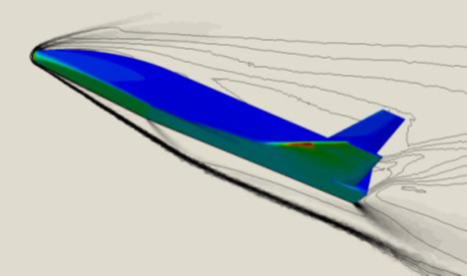SOURCE: ISRO

The Computational Fluid Dynamics (CFD) software “Parallel RANS Solver for Aerospace Vehicle Aero-thermo-dynamic Analysis” (PraVaHa) is developed in VSSC to simulate external and internal flows on launch vehicles, winged & nonwinged re-entry vehicles.
Initial aerodynamic design studies for launch vehicles demand evaluation of a large number of configurations. Any aerospace vehicle while moving through the earth’s atmosphere during ‘launch’ or ‘reentry’ is subjected to severe aerodynamic and aerothermal loads in terms of external pressure and heat flux.
Understanding the ‘airflow’ around aircraft, rocket bodies, or Crew Module [CM] during earth re-entry is essential to design the shape, structure, and Thermal Protection System [TPS] requirements for these bodies. The unsteady part of aerodynamics contributes to serious flow issues around such rocket bodies and creates significant acoustic noise during the mission. Computational Fluid Dynamics [CFD] is one such tool to predict the aerodynamic and aerothermal loads which solve numerically the equations of conservation of mass, momentum, and energy along with the equation of state.
Presently, CFD is matured enough in terms of its accurate prediction capability for complex aerodynamic flows, as well as faster simulation turnaround time on High-Performance Computing Clusters. This makes it handy for the design and characterization of many initial designs so that a few optimum configurations can be selected for detailed evaluation.
PraVaHa has been used extensively in the Gaganyaan program for aerodynamic analysis of human-rated launch vehicles, viz, HLVM3, Crew Escape System [CES], and Crew Module [CM]. It is designed to make use of CPU as well as GPU architecture of available and upcoming supercomputing facilities. The software framework is quite flexible & secure enough, to have collaborative development with academic institutes and government labs.
Currently, the PraVaHa code is operational to simulate airflow for Perfect Gas & Real Gas conditions. Validations of the code are underway for simulating the effect of chemical reactions that occur during air dissociation upon ‘earth re-entry’ and ‘combustion’ as in scramjet vehicles.
PraVaHa soon will replace most of the CFD simulations for aero characterization, which is currently being carried out using commercial software. This indigenous software is going to help academia and other institutions, engaged in the design of missiles/aircraft/rockets, to find solutions to complex aerodynamic problems. By making this product available to larger sections of society, ISRO aspires to lend a helping hand, to move forward in achieving the stated goal of Atmanirbhar India.